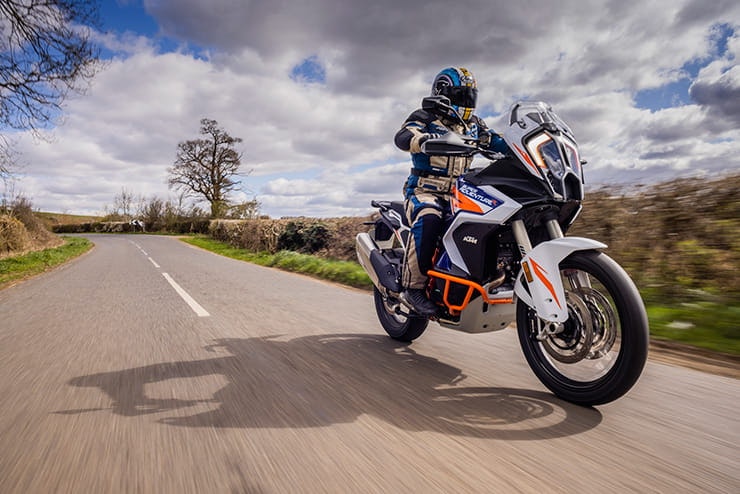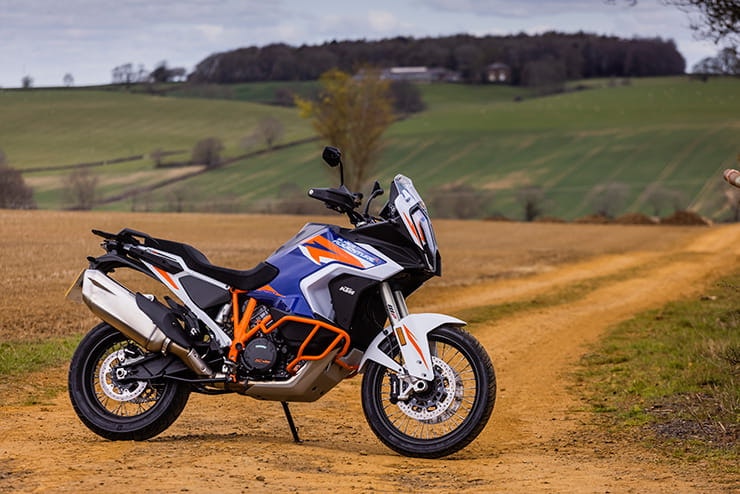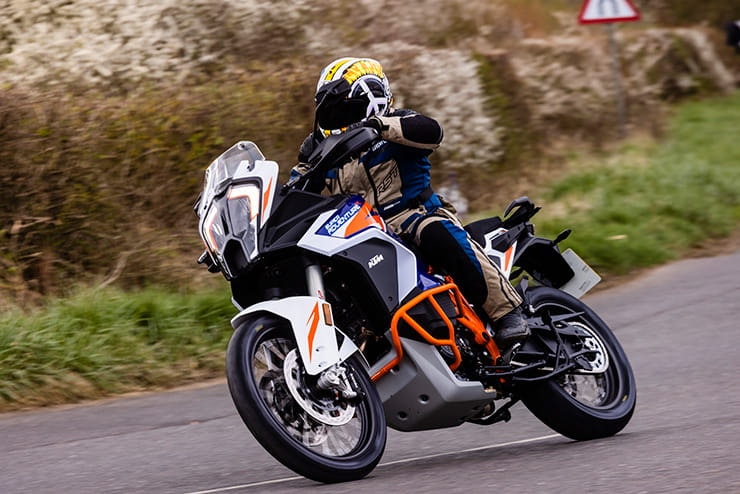KTM 1290 Super Adventure R (2021) - Review
BikeSocial Road Tester
26.04.2021
Let me take you back to 2017. KTM invited me to ride the very latest 1290 Super Adventure R in Peru. Yes, you did read that right, Peru. It was a memorable trip and a memorable bike. We rode in the dunes taking on some serious off-roading, it was 35-degrees plus… and the R was breath-taking. I’m no off-road riding god, but the bike made me look good – like one of those KTM guys you see on the adverts… ish… if you squinted. What a fantastic bike.
Fast-forward to early 2021 and instead of South America, I’m in South Northamptonshire but when KTM opened the garage door to their workshop at Silverstone (next to the GP track), a smile crossed my face despite the sub-zero temperatures because, arguably, the new version is even more desirable than before.
My only major criticism of the now old R was its physical size. It was a big bike, especially for me at 5ft 7in. But KTM has addressed that for 2021 with a new subframe that has reduced the seat height, made it narrower and made the bike more accessible, and now 880mm from 890mm.
But that is only the tip of the iceberg. KTM has met Euro-5 standards without losing any power from that scorchingly torquey 160hp V-twin, and added even more advanced rider aids, accessible via a new 7in TFT dash and switchgear. The bodywork is all-new with split fuel tanks, one either side, a new quick-access air-box and new LED lights to name but a few of the changes.
We have on test the very latest R version which uses the same platform as the more road-biased S version but caters more for the demands off-road (think of the R as the S on steroids, basically). Semi-active WP suspension has been replaced by conventional, manually tweakable suspension, with more travel (up from 200mm to 220mm). Wheels are now spoked and tubeless, the front with a 21in diameter, up from 19in on the S. The changes in wheel size and suspension mean a more relaxed rake and trail. Ground clearance has increased, the screen is smaller and shorter… again, mods aimed at the more serious off-road adventurer.
The old bike was good, still is, so the new R is going to have to be superb. Sadly, a few days in the UK were never going to replicate a week in Peru but the R still shone.
Fantastic engine
Clear dash
True off-road capabilities
Fiddly indicator switch
More off-road biased tyres should be an option
Marmite looks
KTM 1290 Super Adventure R Price
How much is the 2021 KTM 1290 Super Adventure R? £15,999 (as tested with tech pack (£878 = £16,877)
KTM’s Super Adventure R comes in at an extra £1000 above the S despite the fact it doesn’t have semi-active suspension or adaptive cruise control, and there isn’t a radar fitted to the R, not even in the options menu. However, you do get very trick and easy to adjust WP suspension.
Our test bike was fitted with the tech pack, which features the Rally Pack riding mode, Moto Slip Regulation, Hill Hold Control, quickshifter and adaptive brake light. That’s a lot of gadgets for under £900, but I would have expected the quickshifter to be standard.
A quick look at the competition, and the base sepc of Ducati’s all-new V4 Multistrada and BMW’s legendary R1250GS appear cheaper, but that’s not quite the case. To achieve a similar spec to the KTM R, you’re going to need to spend upward of £18,000 on the Ducati and BMW – and both only come with a 19in front wheel.
If you want a big adventure bike with a 21in front wheel, plus long-travel suspension, then you’re going to have to opt for Honda’s Africa Twin. The base model starts at just over £13,000, a considerable saving over the KTM. But it can’t match the Austrian’s power, torque or tech. In fact, the KTM R makes the same power in its restricted off-road mode as the Honda does at peak power.
Power and torque
Thanks to Euro-5 regulations, KTM has been forced to clean up their 1301cc V-twin. They’ve done so with revised fuelling and a completely new exhaust with dual catalytic converters. Despite all the engine and power train-related amends for Euro-5, KTM hasn’t lost any peak power and torque, still quoting 118kw (160hp) @ 9000rpm, and torque at 138Nm (102ftlb) @ 6500rpm. OK, peak power is set slightly higher in the rev range, 250rpm higher than before, and we have lost one, yes one, ft lb of torque, but on such a powerful bike these small numbers are barely insignificant.
KTM hasn’t just cleaned up its LC8 engine, it’s now lighter, too. Thinner engine cases have clipped 1kg, and the big 75-degree V-twin is now 1.6k lighter overall. A neat trick is the redesigned the air-box, which is now located above the engine. Remove the useful storage compartment just in front of the fuel cap, and you have access to the air filter, making it easy to clean after a day off-road in the dust. It’s a nice and welcome touch.
Engine, gearbox and exhaust
The V-twin has so much go… and it delivers from low down and drives with real force and acceleration. You don’t expect a bike that caters for off-road riding, has long-travel suspension and a large 21in front wheel to be so stunningly rapid, but it is. It took me a while to re-configure and get used to its immense low and mid-range drive.
The stock R has four rider modes – Sport, Street, Rain and Off-road – which alter the power, engine character and rider aids, which are now linked to a new 6-axis IMU (just the 5-axis previously). Street and Sport are full power, with Rain and Off-road limited to 100hp, which, as mentioned, is around the same as Honda Africa Twin in full power.
As we’ve come to expect from KTM, the rider aids are excellent, but they are on the racy side. In Sport mode, with a direct throttle connection and ‘soft’ rider aids, the front wheel is allowed to lift reasonably high before intervention, and the reintroduction of power is smooth and quick. If you’re brave and deactivate the rider aids then ride aggressively, the front will lift in the first three gears, any crest or humpback bridge sending the new LED headlight skywards. The rear suspension is now manually adjustable as opposed to the semi-active on the S model. This means the R version is more wheelie prone and gives the electronic rider aids a busier time keeping everything in order. Personally, I found all this fun almost comical at times. But don’t worry, flick the R into the Street mode or use the option Rally mode and you can personalise a setting to control all the one-wheel shenanigans.
Despite KTM’s ‘ready to race’ slogan, the KTM has a sensible side, just. On the motorway, in the tall sixth gear, the engine is hardly working, and there’s still ample grunt on top to embarrass the Mercedes driver who’s tailing you a little too close with a quick wrap of the throttle.
As mentioned, I expected the quickshifter to come as standard, especially because it works so smoothly and effortlessly, especially at speed. But you could argue that it’s not needed. The KTM has so much torque, you only need the top three gears for legal riding…
Handling, suspension and weight
221kg dry, then add a full tank of fuel, 23 litres, and we are close to 250kg. Then add the rider, and combine all the above with long (220mm) travel suspension, a 21in front wheel, a relatively skinny 150-section rear Bridgestone and 160bhp… it could be a recipe for disaster. But KTM has done the unthinkable and made it thoroughly usable.
The WP XPLOR suspension is hugely effective despite needing to work off- as well as on-road. Yes, there is a lot of suspension movement, you can feel the rear squat under power, and the strong Brembo brakes get the forks diving like a Premiership footballer, but the movement has control. The compression of the suspension is well-mannered, the forks are not allowed to dive freely. Equally, when you release the brakes, the forks don’t fire back to the rider like a jack-in-a-box, it’s smooth and controlled. You feel a connection with the chassis and the bike, which then translates to the excellent Bridgestone A41 rubber. Experienced riders will soon start to de-tune the rider aids and begin instead to revel in the feel and mechanical grip. That said, I did get a little carried away a few times and was thankful I’d not fully deactivated the rider aids.
It’s a pleasure to ride briskly, the feedback is excellent. Normally on a tall adventure bike with long-travel suspension you feel distant from the contact patch, the feedback is lost in translation, but not on the KTM. There is a closer connection with the more aggressive chassis. Don’t underestimate the KTM, it can hustle, ride it like a big Supermoto and have some fun.
Off-road the big change for me and most riders is the sub-frame which allows the seat to be dropped by 11mm. The seat is also narrow at the tank, and KTM have moved the weight lower and forward by pitching the engine in the frame, and now the 1290 feature the ‘three cell fuel tanks’, as per the 890 Adventure R. The changes make the big R less intimidating; you feel more in control, the balance is better and less top-heavy. And now when I come to a stop I can touch the floor, just.
We only got to tickle the new bike’s off-road capabilities, but combined with user-friendly off-road rider aids, the R appears to be more accessible than before. More than ever it feels easier for less experienced riders and, especially, for those like myself who are vertically challenged.
KTM 1290 Super Adventure R Comfort and economy
Cruise control comes as standard but, unlike the S, the Adaptive Cruise Control isn’t even listed an optional extra. However, the new switchgear makes activating and changing the cruise speed simple and straightforward. In fact, the 7in TFT dash is both visually impressive and functional. I have heavily criticised KTM clocks and switchgear in the past, but this is a steep improvement – intuitive to use with everything on hand for some serious touring.
The R features a smaller screen compared to the S, which is beneficial off-road, but obviously doesn’t give you the same wind protection at high speed. It’s still manually adjustable, but now lower. While I found its height satisfactory, I’m sure taller riders may opt for a taller option.
The seat differs from the S, too, and there are 11 different seat options, though I had no complaints from the standard seat. Because the seat height has been reduced, the pegs (with removeable rubbers for off-road riding) now feel closer. It’s still a roomy riding position, but exceptionally tall riders may prefer to set the seat into the higher position or opt for the taller seat, which would increase the legroom further. Bars, pegs, screen and levers are adjustable to get the riding position right, optimised for the journey you’re about to embark on.
The saddlebag-style, 23-litre fuel tank should give a decent tank range of around 200 miles before you need to panic about fuel. I managed 46mpg, which equated to a theoretical range of 234 miles. Several hours in the saddle shouldn’t be a problem as the suspension fatiguing road imperfections with ease. The small compartment in front of the keyless fuel cap is useful for storing a mobile phone, and there’s a USB charger in there too. As you’d expect these days, the new clear full colour clocks have Bluetooth connectivity.
I like the spacious riding position, the cockpit is a comfortable and a happy place to spend a few hours, that’s slightly let down by the indicator switch, which isn’t positive enough – sometimes it’s on, sometimes not. Maybe I’m picky, but I’d prefer a more positive action.
KTM 1290 Super Adventure R Brakes
Brakes remain unchanged from the previous model with Brembo radial callipers still grabbing twin 320mm discs. The cornering ABS is excellent, and you can de-activate the rear brake ABS, while in the off-road mode the ABS is designed to work on gravel and lose terrain. Some ‘experts’ may feel the need to switch off the ABS entirely, but I’d strongly argue against that. The ABS is very impressive both and on and off-road. Again, the feedback and control from the excellent 48mm WP forks allows you to make the most of the Brembo’s strong stopping power.
Rider aids, extra equipment and accessories
The list of standard equipment on the KTM is impressive. Four riding modes, now linked to the new 6-axis IMU which communicates to a plethora of rider aids. A new 7in TFT screen with new backlit switchgear makes this all accessible. Keyless ignition, which also actuates the fuel cap and seat (yes, an electronic locking seat!). Tyre pressure control, a 12v socket and USB charger in the storage compartment… all standard. It’s just a shame the quickshifter is optional. The hill hold control is also an optional extra, which some people love and some hate. KTM offer touring cases made from aluminium by Touratech. A top box isn’t listed in the accessories, but a soft luggage bag is. And obviously KTM offer a Akrapovic slip-on silencer.
Rivals
KTM 1290 Super Adventure R Verdict
I was a huge fan of the old bike, both off and on-road, but KTM has moved the game forward. The new R is far more accessible for most riders. The new sub-frame, seat, and multi-adjustable controls (11 seats to choose from) mean the R will now fit everyone and isn’t as intimidating as before. The new switchgear, impressive TFT dash and electronic rider aids are a significant step forward too. On-road, the sharper handling is superb, and the long-travel suspension has a high level of control. Off-road, we only got a taste of what the bike can do, but it should be an improvement over the old bike, which set a very high standard. I like the styling and looks but would prefer more off-road biased rubber as standard. A great bike, then, made even better – well done, KTM. My test ride may have lacked the rigours of Peru, but it didn’t dampen the bike's appeal.
KTM 1290 Super Adventure R Technical Specification
Photography: Jason Critchell
What is MCIA Secured?
MCIA Secured gives bike buyers the chance to see just how much work a manufacturer has put into making their new investment as resistant to theft as possible.
As we all know, the more security you use, the less chance there is of your bike being stolen. In fact, based on research by Bennetts, using a disc lock makes your machine three times less likely to be stolen, while heavy duty kit can make it less likely to be stolen than a car. For reviews of the best security products, click here.
MCIA Secured gives motorcycles a rating out of five stars, based on the following being fitted to a new bike as standard:
A steering lock that meets the UNECE 62 standard
An ignition immobiliser system
A vehicle marking system
An alarm system
A vehicle tracking system with subscription
The higher the star rating, the better the security, so always ask your dealer what rating your bike has, and compare it to other machines on your shortlist.


